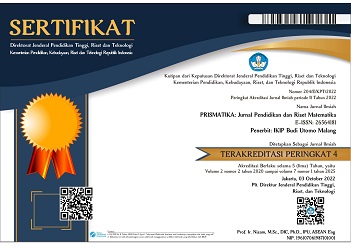ANALISIS PROBLEMATIKA PEMBELAJARAN MATEMATIKA SEKOLAH MENENGAH PERTAMA
Abstract
This research aims to describe problems in mathematics learning and their solutions at Kawali 1 State Junior High School. The research method used in this research is a qualitative. The research subjects were six students from class IX and two mathematics teachers at SMP Negeri 1 Kawali who taught in class IX. The research instruments used in this research were observation, questionnaires and interviews. The learning problems that have been widely researched are problems related to students, even though teachers also need to be researched, so the advantage of this research is describing mathematics learning problems for students and teachers. The results of this research show the problems of mathematics learning at SMP Negeri 1 Kawali, namely that teachers are less innovative and creative when learning, less mature understanding of mathematical concepts, low ability of students to think creatively in mathematics, and low motivation of students. An alternative solution to this problem is that teachers must continue to learn or upgrade their knowledge regarding teaching styles, methods and learning media, teachers must be able to provide scaffolding, teachers must be able to train and hone students' creative thinking skills with learning that raises everyday problems that arise. non-routine, and the teacher must provide guidance and a psychological approach and the teacher must be clever in choosing suitable learning media in conveying Mathematics subject matter.
References
Hirtanto, H., Mardiyana, M., & Sujadi, I. (2015). Eksperimentasi Pembelajaran Matematika Menggunakan Media Komputer Pada Materi Pokok Persamaan Garis Lurus Ditinjau Dari Motivasi Belajar Peserta didik Kelas VIII SMP Surakarta.Jurnal Pembelajaran Matematika,3(8).Kamphaus, R. W., dkk. (2000). Current Trends in Psychological Testing of Children. Professional Psychology: Research and Practice, 31, 155-164.Kamsinah, K. (2022). Problematika dan Solusi Pembelajaran Matematika pada Tingkat Madrasah Tsanawiyah.ULIL ALBAB: Jurnal Ilmiah Multidisiplin,1(9), 3214-3231.Khatimah, K., Sadijah, C., & Susanto, H. (2017).Pemberian scaffolding untuk mengatasi hambatan berpikir peserta didik dalam memecahkan masalah aljabar.Jurnal Kajian Pembelajaran Matematika,1(1), 36-45.Mazzocco M. M., & Myers G. F. (2003). Complexities in Identifying and Defining Mathematics Learning Disability in the Primary School Age Years. Annals of Dyslexia, 53: 218-253.Mundla, L. (2012). The Assessment of Math Learning Difficulties in a Primary Grade-4 Child with High Support Needs: Mixed Methods Approach. International Electronic Journal of Elementary Education, 4(2), 347-366.Permatasari, K. G. (2021). Problematika pembelajaran matematika di sekolah dasar/madrasah ibtidaiyah.Jurnal Pedagogy,14(2), 68-84.Sari, R. K. (2019). Analisis problematika pembelajaran matematika di Sekolah Menengah Pertama dan solusi alternatifnya.Prismatika: Jurnal Pendidikan dan Riset Matematika,2(1), 23-31.Soedjadi, R. 2001. Nilai Nilai dalam Pendidikan Matematika dan Upaya Pembinaan Pribadi Anak Didik. Surabaya: Unesa.Steenbrugge, V. H., dkk. (2011). Mathematics Learning Difficulties in Primary Education: Teachers’ Professional Knowledge and the Use of Commercially Available Learning Packages. Publication in Educational Studies.Suryadi, S. (2015). Peranan perkembangan teknologi informasi dan komunikasi dalam kegiatan pembelajaran dan perkembangan dunia pendidikan.Informatika,3(3), 133-143.Suyatno. (2009). Menjelajah Pembelajaran Inovatif. Sidoarjo: Masmedia Buana Pustaka.Undang-Undang Republik Indonesia tentangSistem Pendidikan Nasional 20 Tahun 2003.Veirissa, A. H. (2021). Kualitas Guru di Indonesia. InProsiding Seminar Nasional Pascasarjana (PROSNAMPAS),4(1), 267-272.







.png)




